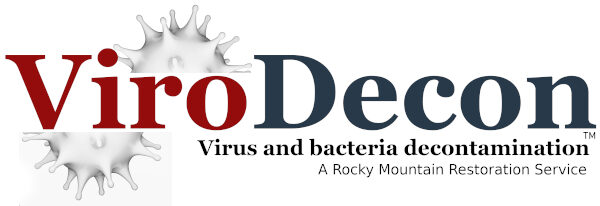Unlike bacteria, viruses are not alive, they are smaller than single-celled organisms and depend on a host to replicate. Below we will explain the differences.
Viruses much smaller than cells and are not living things:
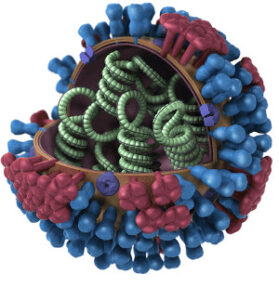
Scientifically a “living” organism must fulfill all of the five points below:
- Perform metabolism
- Have the capacity for reproduction – a virus has only this
- Respond to stimuli
- Have complex growth
- Have cellular composition
4 Major Types of Infectious Agents:
- Viruses – We decontaminate both enveloped and non-enveloped viruses
-
- Viruses are the second-smallest infectious particle at an average of 70 nanometers
- Viruses come in many variations, see more about this below in this article
- Is not a life form
- Example: Influenza, Ebola, Coronavirus, Norovirus, Swine Flu (H1N1)
-
- Infectious Biomolecules – Prions are extremely resistant to most methods of decontamination and sterilization
-
- ViroDecon does not currently sterilize instruments and spaces contaminated with prions.
- Prions are exclusively made of proteins, they are the smallest infectious particle that threatens humans. Chronic Wasting Disease, Bovine Spongiform Encephalopathy and Alzheimer’s Disease are examples of disease caused by prions.
- Is not a life form
-
- Bacteria – We decontaminate most forms of bacteria
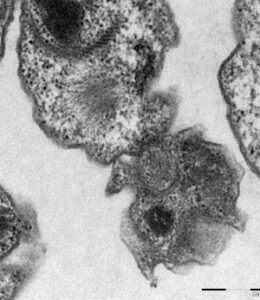
Bacteria. These examples are about 500 nanometers in width. -
- Example: the medieval Plague – bacteria yersinia pestis entered the human body via the bloodstream during a flea bite. The bacteria replicates in the warm moist environment of the lymph nodes and makes billions of versions of itself. It does not enter a human cell to hijack the cell.
- Is a life form
- Size difference: bacteria vs. virus (500 nanometers wide vs. 70 nanometers wide)
-
- Fungus –We remove and decontaminate mold
-
- Fungus is a life form which replicates differently than virus or bacteria, it uses mobility – sending spores out in the world.
- Fungus is a life form
- Mold, yeast, etc. spreads its spores through air or water. Some species produce mycotoxins which can poison you immediately or result in long term damage in the form of immune deficiency, reduced brain function or cancer. Growing up in a dirty house, or a house with mold in the basement for example can result in learning deficiencies, asthma, and a whole list of problems as mold affects each person differently.
-
How a virus attacks
Human cells are factories, viruses continue to exist by hijacking those factories for their own use in replicating the virus. This is the most important fact.
- The Lytic Cycle: a virus injects RNA or DNA into a living cell of an organism and either forces the cell to make copies of the virus and the cell explodes in the process.
- The Lysogenic Cycle: the virus injects its RNA or DNA, which attaches to the cells DNA and insidiously allows the cell to continue its functions and replicate the cell, but each daughter cell has the virus’s DNA or RNA ingrained. Then, at a certain signal, all the cells could lyse together (create viruses and explode releasing the viral particles).
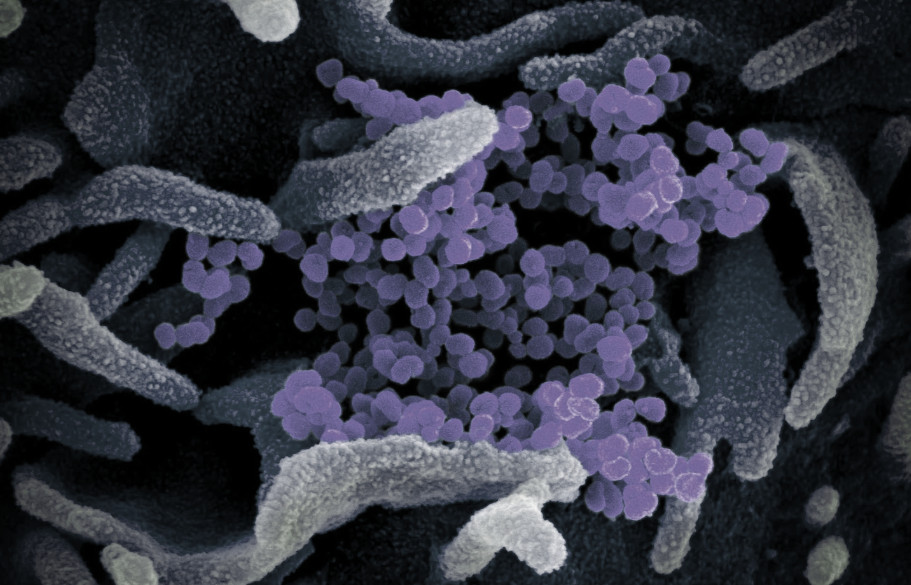
The shape of a virus
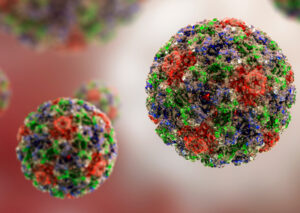
Rod-shaped – some viruses are long and shaped like a stick, they are a coiled RNA strand with protein subunits attached on the outside.
Icosahedral shaped viruses – multi-faced solid objects.
Membranous enveloped viruses – has a casing protecting the proteins on the inside, often they are round, but they can be irregular and “worm-shaped” like ebola.
Complex Structure (Bacteriophage) – Can look like robots or a lunar lander – see photo at the end of this article.
Enveloped viruses
We disinfect both enveloped and non-enveloped viruses at ViroDecon. So what is the protein and lipid envelope for in an enveloped virus?
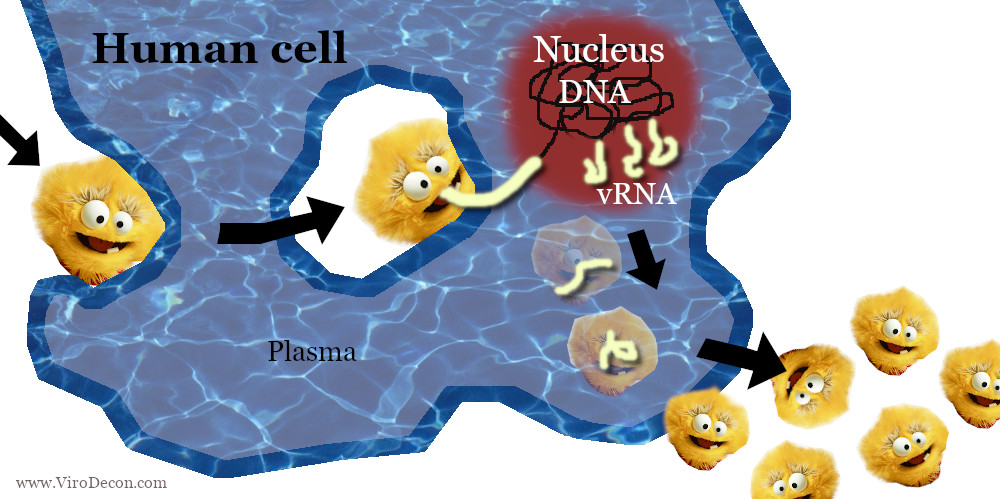
-
-
- Tricking the cell: In the cartoon above we have a “happy” and harmless

Viruses need to match the cells of the species or they are rejected, this is why humans don’t get viruses that our pets can get. exterior that tricks the cell into letting the virus enter. Chemically the cell “shakes hands” with the virus (connects to cell receptors) and binds to the sialic acid residues. The virus must be specifically able to match the type of cell receptor, otherwise the virus is rejected. This is why many animal viruses don’t infect us.
- Hijacking the cell: After entering the cell the virus releases its DNA or RNA which connects to the DNA in the nucleus of the cell. The DNA strands tell the cell what to do, they are a set of instructions. We call this process transcription. The virus RNA (influenza) gets the nucleus to start producing vRNA or the virus’s RNA and exporting it from the nucleus into the plasma.
- Pack and ship: the vRNA builds an envelope from the plasma membrane material (in blue in the cartoon) and exports the viral particles to colonize other cells. Most enveloped viruses “bud” out of the cell.
- Tricking the cell: In the cartoon above we have a “happy” and harmless
-
Non-enveloped viruses
Hard to kill! There is no lipid-bilayer membrane on this type of virus. It still has a protective protein layer. It has a different mechanism of infection and may not need to be welcomed into the cell. Both could look like a sphere, but there is no second layer on the non-enveloped version. The bacteriophage (picture below) is a famous and iconic type of virus.
Structure:
We see an assembly line type pattern in these viruses. The Adenovirus hexon for example is “mass produced” and has a scaffold to ensure rigid and reoccurring structure. The bacteriophage P22 for example is different in that it is more dynamic in protein structure.
Examples: adenovirus(AdV), human papillomavirus (HPV) and polymavirus (PyV), Rotavirus
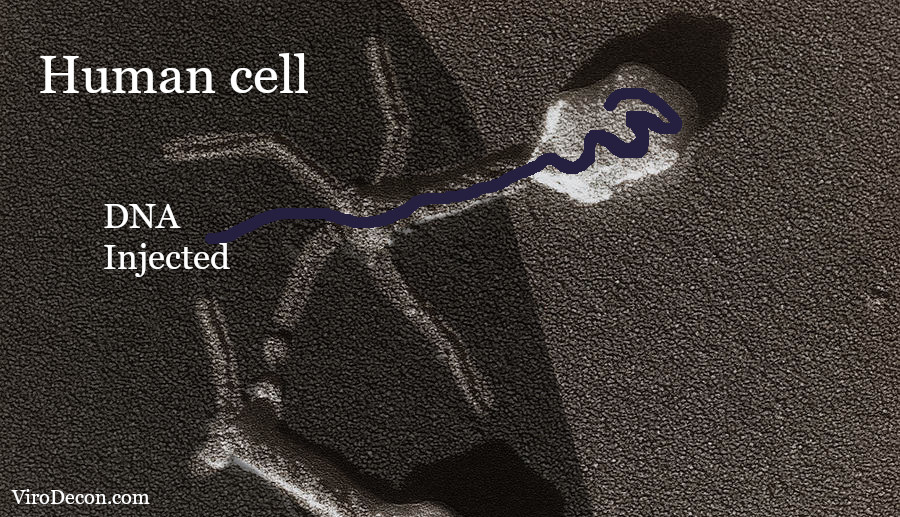
NEXT: How long does a virus or bacteria live on a surface?
Back to ViroDecon decontamination services >
Sources:
Influenza A: Understanding the Viral Life Cycle. The Journal of Biology and Medicine
https://www.ncbi.nlm.nih.gov/pmc/articles/PMC2794490/
CDC Center for Disease Control, Atlanta, GE
Rice Biological Electronmicroscopy Lab
Mycotoxins. World Health Organization
https://www.who.int/news-room/fact-sheets/detail/mycotoxinsFungus. Wikipedia
Alzheimer’s Disease isa Double-Prion Disorder, Study Shows. UC San Francisco. 2019
https://www.ucsf.edu/news/2019/05/414326/alzheimers-disease-double-prion-disorder-study-shows
Prion Sterilization Guide
https://consteril.com/prion-sterilization-guide/
